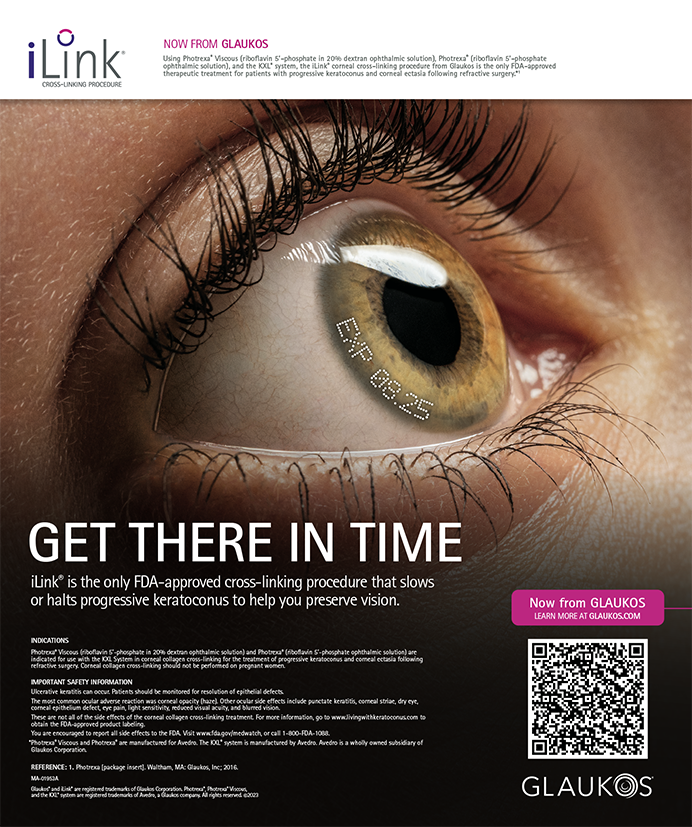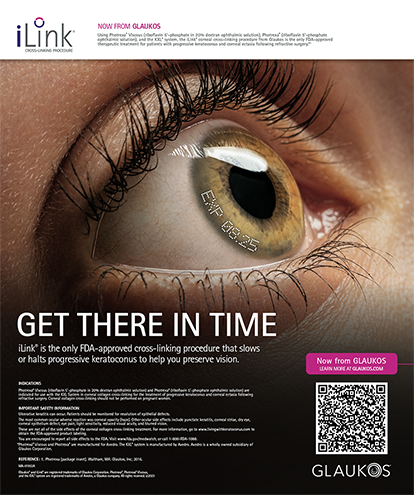A debate is raging within the electronic forums of refractive surgery that I would like to address. How important is pupil size in modern keratorefractive surgery? Physicians are taking two basic positions. Some believe that the LASIK treatment optical zone must at least match that of the scotopic pupil. For example, if a patient with a refractive error of -7.0 D has a 7.5-mm pupil and desires LASIK or PRK, the surgeon should try to match the optical zone to the scotopic pupil (7.5 mm). This surgical plan (optical zone size = scotopic pupil size) grows out of conclusions drawn from PRK studies in the early 1990s that noted that patients with 6-mm optical zones logged fewer subjective halo and glare complaints than patients with 4- to 5-mm optical zones. This theory of increasing optical zone size to minimize subjective complaints of night vision does have a scientific basis. I believe it is a gross mistake, however, to draw major conclusions from studies that utilized first-generation excimer laser technology and techniques. Refractive surgeons bolster this surgical argument with case reports of patients who have large pupils and severely debilitated night vision after undergoing LASIK or PRK with optical zones smaller than their scotopic pupil. Furthermore, surgeons are now using wavefront devices to support patients' complaints of postoperative night vision symptoms. Unfortunately, wavefront technology only measures physical aberrations, not patient perceptions which may be affected by the Stiles-Crawford effect and other factors. Those using modern excimer lasers have been able to expand optical zones and remove greater tissue volume in order to match the optical zone size to the scotopic pupil. For many highly myopic patients who lack adequate preoperative corneal thickness for LASIK, PRK/LASEK may be substituted for deeper (higher volume) ablations. It would be unwise, however, to perform higher volume/deeper ablations without well-designed clinical investigations into the long-term effects and potential benefits of such off-label treatments. My experience using larger ablation zones matched to scotopic pupil size has led me to the following findings.
SURPRISING CONCLUSIONSAs a refractive surgeon, I believed much of what our fellow ophthalmologists said about pupil size. I carefully implemented recommendations on matching optical zone to pupil size, only to be surprised with the following clinical conclusions:
1. Variable optical zones result in multiple nomograms and decrease the probability of achieving emmetropia.
2. Increased optical zones are extremely inefficient, removing up to 40% more corneal tissue.
3. Incidence of subjective night vision complaints due to larger optical zones does not appear to be appreciably less compared to that with smaller optical zones (6.0 mm) in patients matched for pupil size and level of myopic correction.
CAUSES OF NIGHTTIME VISION SYMPTOMS
It is far easier to attribute a patient's subjective visual complaint to obvious explanations (large pupil, smaller optical zone) than to a more complex and subtle explanation. Utilizing four separate excimer laser platforms over the past 4 years, it is clear to me that the following (in descending order) are the most likely causes of chronic postoperative night vision complaints:
Residual ametropia. Halos are basically myopic, blurred circles surrounding point sources of light. If the patient is even mildly myopic and/or astigmatic, the residual ametropia coupled with a nighttime myopic shift can certainly elicit complaints.
Magnitude of correction. Patients with higher levels of correction have a higher probability of nighttime visual complaints. Theory points to increased postoperative higher-order wavefront aberrations. These patients usually demonstrate larger degrees of residual ametropia (lower-order aberrations), greater degrees of treatment decentration, and a greater degree of technical difficulty required in performing the ablation and keratotomy.
Optical zone decentration. Even when the optical zone is equal to or greater than the scotopic pupil, a decentration greater than 0.5 mm can produce significant visual complaints. Unfortunately, high myopes with large pupils present a greater technical challenge in terms of treatment centration and patient fixation.
Optical zone drift. This phenomenon, characterized first by initial optical zone centration, then eye movement as the ablation proceeds, and finally resulting in a drift in the optical zone, is an underdiagnosed cause of decreased UCVA, BSCVA, and night vision issues.Flap striae. Higher myopic ablations create a greater curvature disparity between the flap and stromal bed. If the flap is excessively hydrated and not tightly stretched over the treatment bed at the time of surgery, unwanted flap microstriae occur, which can be a significant source of night vision complaints.
Multizone ablations. In my experience, there is a higher probability of night vision complaints with multizone ablations. Unfortunately, some excimer laser platforms default above a certain dioptric level to a multizone algorithm. These place an even greater emphasis on treatment centration and are associated with a higher incidence of postoperative night vision complaints.
Many of the factors described above are interrelated and can be combined to provide a working hypothesis to explain many patients' postoperative night vision complaints. A significant percentage of postoperative night vision complaints may be related to the lamellar aspect of the surgery. In a study comparing LASIK to PRK, Mihai Pop, MD, concluded that LASIK patients were twice as likely to experience halos postoperatively.1 Considering the above list, it is obvious that highly myopic patients are at the greatest risk for postoperative visual complaints. In my experience, patients treated with a broad-beam excimer laser, with a 6.0-mm single zone myopic sphere or 5.0-mm X 6.5-mm single zone myopic cylinder, demonstrate a 3% incidence of mild to moderate nighttime visual symptoms (halos, glare, starbursts, and/or decreased contrast sensitivity).
A MOOT POINT?
In the past 3 years, investigations utilizing modern excimer platforms have focused on the effect of pupil size on nighttime visual complaints. In separate studies using the EC-5000 excimer laser (NIDEK Co., Ltd, Fremont, CA), the Technolas 217 laser (Bausch & Lomb, San Dimas, CA), and the Star S2 excimer laser (VISX, Inc., Santa Clara, CA), researchers have concluded that, when utilizing modern optical zones, pupil size is not correlated with postoperative complaints of glare and halos.2-6 Some of these researchers have also noted that an increase in postoperative night vision symptoms appears to be correlated to the attempted level of spherical equivalent correction. If there is still any doubt that modern lasers with optical zones of 5.5 to 6.5 mm (associated with blends) have virtually eliminated ablation algorithms as the source of subjective nighttime visual complaints, I will briefly review a study described by Mark J. Cohen, MD, (president of the Canadian Association of University Professors of Refractive Surgery).6 The purpose of the study was to address the Canadian public's raised awareness of night vision problems due to LASIK. Dr. Cohen noted that 35% of patients preoperatively reported symptoms of glare, halos, and starbursts, and this percentage remained constant postoperatively. Utilizing a modern excimer platform, LASIK was performed on 26,000 myopic eyes. In reviewing subjective symptoms and related functional problems postoperatively, only six patients had a significant night vision complaint that was not correctable with glasses.
With modern excimer lasers and techniques, pupil size has become a moot point. It is unlikely that surgeons can eradicate all night vision complaints, and it is inadvisable to attempt to do so by removing greater volumes of precious corneal tissue by dogmatically trying to match the optical zone to the scotopic pupil size. Continuously improving surgical equipment and techniques, practicing clear physician-patient communication, and obtaining detailed surgical informed consent including computerized night vision simulations (that duplicates night vision problems such as halo, glare, starbursts, ghosting, and contrast reduction) can significantly decrease the number of patients with nighttime visual complaints.
Sam Omar, MD, is from Advanced Vision Institute in Orlando, Florida. Dr. Omar may be reached at (407) 389-0800; omar_eye@yahoo.com1. Pop M, Payette Y: Photorefractive keratectomy versus laser in situ keratomileusis: A control-matched study. Ophthalmology 107:251-257, 2000
2. Pop M: Fall ISRS Symposium, Nov 2000, Dallas, TX
3. Schumer J: Pupil protocol: A prospective analysis of LASIK using varied treatment sizes based on dark-adapted pupil size. Fall ISRS Symposium, Nov 2001, New Orleans, LA
4. Haw W, Manche E: Effect of preoperative pupil measurements on glare, halos, and visual function after photoastigmatic refractive keratectomy. J Cataract Refract Surg 27:907-916, 2001
5. Shallhorn S: Pupil size irrelevant to post-LASIK complaints. Ocular Surgery News, Vol. 20, No. 6, March 15, 2002
6. Cohen MJ: Night vision symptoms: A preventable complication. Refractive Eyecare May 2001, Vol 5, No. 5 (suppl)


